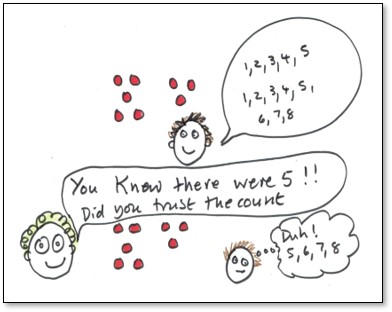Trusting the Count is not a Secret
Last year I was in a year one classroom where the students were working on a problematized situation. Two little girls were sitting close together. One of the girls counted five strawberries that she had just drawn and then drew 3 more and went back to the beginning to count them all again. The other little girl watched, all the time shaking her head.
“Did you trust the count?” She asked her friend.
Her friend slapped herself on the head, said “Duh” or something like it, chuckled and then pointed at the 5 and counted on.

I thought it was a lovely interlude, but it set me thinking about what we keep secret from our students. The teacher in point had told the students that they were learning to trust the count. She had previously modelled drawing some objects, counting or subitizing them and then asking:
“Do we know how many so far?”
“Now I’ve drawn some more do I need to count them all again or can I trust that there are still the same amount?”
“If I trust the count, what do I need to do to find out how many altogether?”
It was no wonder then that the students were prompting each other to trust the count. If the expression and the explicit modelling of expected behaviour is not shared I guess many students will continue to not trust the count and count all every time.
Another not-so Secret Revealed
Our Trusting the Count on-line course is now ready and available on our website. It has been a while coming but then the course includes lots of videos that introduce hands-on activities, making it seem more like a professional development day with Ann than our earlier courses. We are learning from our WebEx experiences and trying to make things as interactive and hands-on as we can when we cannot be in a face-to-face professional development situation. We had fun making the course and hope that you will have fun using it.
